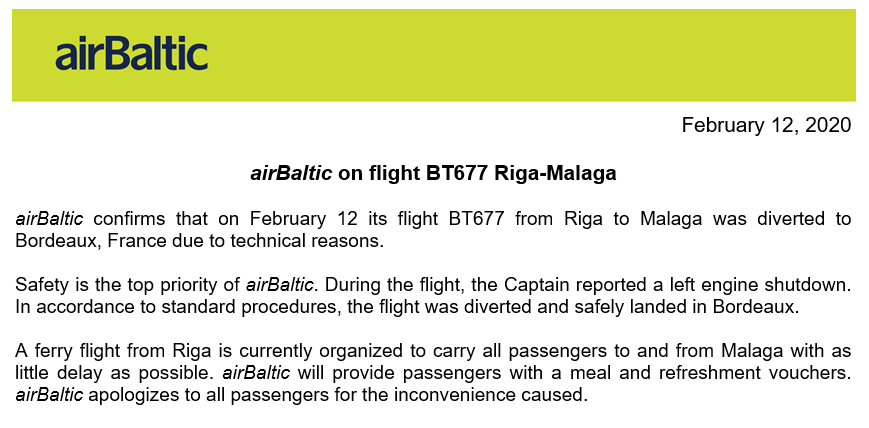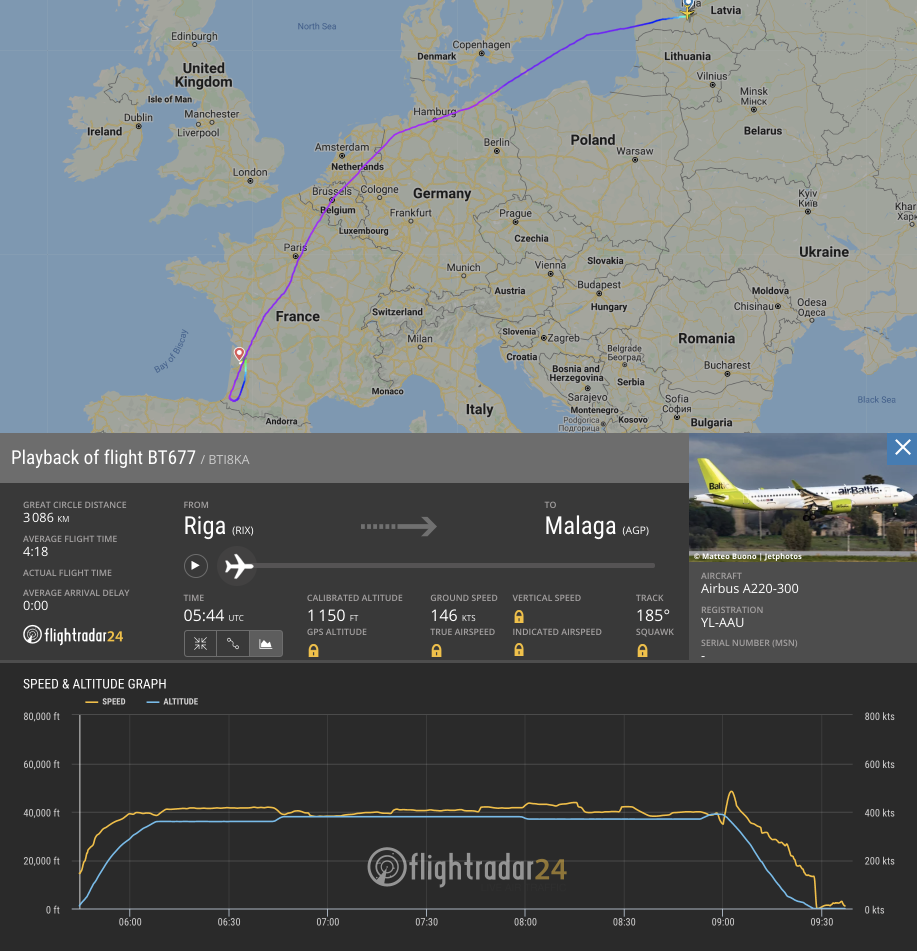
ASN Wikibase Occurrence # 232916
This information is added by users of ASN. Neither ASN nor the Flight Safety Foundation are responsible for the completeness or correctness of this information.
If you feel this information is incomplete or incorrect, you can submit corrected information.
| Date: | Wednesday 12 February 2020 |
| Time: | 10:00 LT |
| Type: |  Airbus A220-300 |
| Owner/operator: | Airbaltic |
| Registration: | YL-AAU |
| MSN: | 55064 |
| Year of manufacture: | 2019 |
| Engine model: | Pratt & Whitney PW1521G-3 |
| Fatalities: | Fatalities: 0 / Occupants: 154 |
| Aircraft damage: | None |
| Category: | Serious incident |
| Location: | south of Bordeaux -
 France France
|
| Phase: | En route |
| Nature: | Passenger - Scheduled |
| Departure airport: | Riga International Airport (RIX/EVRA) |
| Málaga-Costa del Sol Airport (AGP/LEMG) | |
| Investigating agency: | NTSB |
| Confidence Rating: |
Air Baltic flight BT677, an Airbus A220-300, suffered a failure of the no.1 PW1521G engine en route between Riga, Latvia, and Málaga, Spain. The aircraft had just completed an en-route climb from FL370 to FL390 when the engine failed. The flight crew turned back towards Bordeaux and declared an emergency. A safe landing was carried out at Bordeaux–Mérignac Airport (BOD/LFBD) 09:28 UTC.
BEA France delegated the investigation of this serious incident to the NTSB given the similarities with other occurrences. These three occurrences involved inflight shutdowns due to failure of the low-pressure compressor (LPC) stage 1 rotor, which resulted in the rotor disk releasing from the LPC case and damaging the engine.
As an interim measure Transport Canada issued an Airworthiness Directive on October 26, 2019, introducing a new Aircraft Flight Manual (AFM) limitation and normal procedure to limit the engine N1 setting to 94% while above 29000 feet.
The No. 1 engine low pressure compressor (LPC) stage 1 integrally bladed rotor (IBR) failure was caused by a stage 1 IBR high cycle fatigue crack that originated at the runout of an airfoil leading edge root radius. Multiple analytical methods, including two-dimensional (2D) computational fluid dynamics (CFD), acoustic testing, and instrumented flight testing identified a coupled LPC stage 3 and stage 1 IBR instability caused by an acoustic coincidence with the 2.5 bleed valve duct cavity. At high engine N1 speeds, the stage 3 IBR blade tips generate vortices/turbulent airflow and given the right conditions, the turbulent airflow can create an acoustic tone as it passes over the 2.5 bleed valve duct cavity, located immediately aft of the LPC stage 3 IBR (Figure 1). The acoustic tone drove a LPC stage 3 IBR blade 1st bending mode excitation that was then mechanically transferred through the LPC module and excited a LPC stage 1 IBR stiffwise bending mode that was present at the same approximate frequency. The resultant stresses on the LPC stage 1 IBR blades exceeded material limits and subsequently led to crack formation and eventual progression to overload failure.
Factors that contributed to the LPC stage 3 and stage 1 IBR acoustic coincidence and blade excitation within the engine operating range were: installation of electronic engine control (EEC) Software V2.11.7.2 and the low time rub in period on the LPC IBR blade tip clearances.
EEC Software V2.11.7.2 changed the LPC inlet guide vane schedule to rotate the IGV's in the closed direction at specific high power engine conditions to improve engine stall/surge margin. The revised vane schedule inadvertently created conditions that were favorable for generation of the 2.5 bleed valve duct cavity acoustic tone and IBR mode excitation.
New engines have tighter clearances between the LPC IBR blade tips and the outer air seals. The reduced clearance created unsteady loading at the blade tip region and resulted in stronger acoustic coupling/flutter response. After a rub in period, the clearance increases, and the occurrence of flutter onset is reduced.
There were three PW1524G-3 and one PW1521G-3 LPC stage 1 IBR separation events between July 25, 2019 and February 12, 2020 that occurred on multiple operators. The incident detailed in this investigation was the fourth PW1500G series LPC stage 1 IBR failure. The engine parameters at the time of each of the events and the resulting engine damage were consistent. Additional information about the failure mode and investigation process are available in the investigation dockets for the first two incidents, NTSB investigation numbers ENG19IA029 and ENG19IA034.
Probable Cause: A No. 1 (left) engine low pressure compressor (LPC) stage 1 integrally bladed rotor (IBR) separation due to a high cycle fatigue crack (HCF) that originated at the runout of an airfoil leading edge root radius. The HCF crack developed because of a mechanically coupled LPC stage 3 and stage 1 IBR mode excitation and blade flutter response. The excitation was driven by an acoustic tone generated by turbulent airflow passing over the 2.5 bleed valve duct cavity while the engine was operating at high speeds in specific flight conditions. A primary contributor to the failure mode was an electronic engine control (EEC) software update that changed the LPC vane schedule and increased the likelihood of LPC stage 1 IBR blade flutter onset within the engine operating range.
Accident investigation:
 |
|
Sources:
NTSB ENG20LA015
Location
Images:


Revision history:
| Date/time | Contributor | Updates |
|---|---|---|
| 12-Feb-2020 14:56 | harro | Added |
| 12-Feb-2020 14:57 | harro | Updated [Narrative] |
| 12-Feb-2020 16:12 | RobertMB | Updated [Narrative] |
| 12-Feb-2020 17:42 | harro | Updated [Source, Narrative] |
| 12-Feb-2020 17:47 | harro | Updated [Narrative] |
| 12-Feb-2020 20:28 | Iceman 29 | Updated [Photo] |
| 12-Feb-2020 20:28 | Iceman 29 | Updated [Photo] |
Corrections or additions? ... Edit this accident description
The Aviation Safety Network is an exclusive service provided by:


 ©2024 Flight Safety Foundation
©2024 Flight Safety Foundation